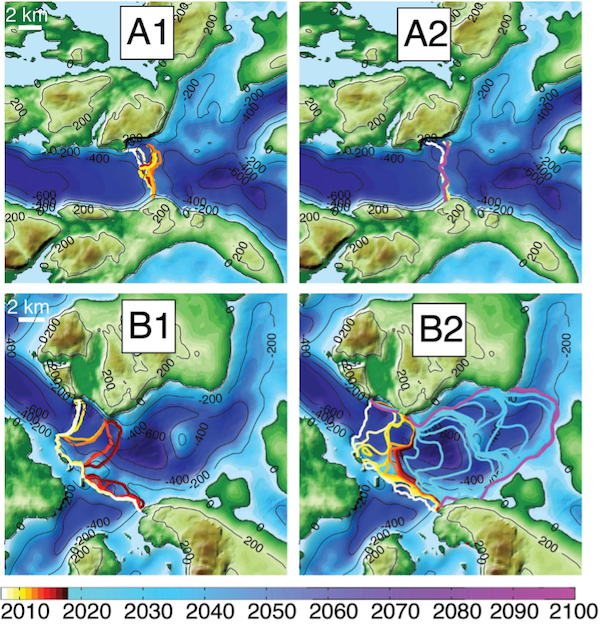Summary
The Snow on Ice Project developed a unique method of integrating data from multiple paleoclimate proxies into a regional model of the SW Greenland Ice Sheet (GrIS) to improve our understanding of changes that occured in that area of the ice sheet. In the GRate project we will both expand that work and refine it to build a more complete and more robust picture of the future of the GrIS. We will include the full ice sheet, adding high spatial- and temporal-resolution simulations of the dynamic evolution of the entire GrIS from 12 ka to 2100 AD. You can listen to Modeling Climate Change: The Greenland Ice Sheet (GIS) and Why It Matters (with Joshua Cuzzone) a podcast summarizing the importance of these findings.
We will work with the Ice Sheet System Model (ISSM) a finite-element 3D thermo-mechanical ice-sheet model that relies on high-order physics to simulate high-resolution ice flow on continental scales. This part of the project will achieve five major advances: (1) expanding the domain to the entire GrIS; (2) updating our treatment of climate forcing through improved treatment of surface mass balance (SMB) of the ice sheet, (3) implementing calving and oceanic melting of ice, a significant advance for long-timescale simulations of the GrIS (4) implementing an offline glacial isostatic adjustment (GIA) model, iteratively employed to compare simulated crustal motion with independent observations of RSL, therefore providing additional model-data constraints, and (5) we will employ an uncertainty quantification scheme as a formal treatment of uncertainty in our simulations of GrIS change.
The modeling for the project will be led by team members from JPL and University of Montana: Josh Cuzzone, JPL, PI, Eric Larour, JPL, PI, Nicole-Jean Schlegel, JPL, PI, Jesse Johnson, Montana, PI, Mathieu Morlighem, Dartmouth, PI.
Model domain and timeframe
During the Last Glacial Maximum the GrIS had extended out onto the continental shelf, but by ~12 ka it had largerly pulled back onto the land. GRate will use the timeperiod from 12 ka to 2014 CE for model starting points, the former for the modeling the past and the latter for modeling into the future. Both will use the same model set up and parameterizations for consistentcy in past-to-future time series. In fjord areas topographic relief is high and these features are important to ice flow and play an important role in where the ice remains grounded, and how it migrates. In these areas the horizontal resolution will be at 1km, whereas in the interior of Greenland it will be 20 kms.
Initiation and boundary conditions
GRate will test the sensitivity of two initiation approaches to modeling the Holocene. The first allows the ice sheet to grow and relax until it reaches the 12 ka ice limit using 12 ka climate boundary conditions. The second allows the ice sheet to grow and relax until it reaches the LGM ice limit using LGM climate boundary conditions.
Surface Mass Balance
SMB will mainly use ‘positive degree day’ (PDD) or the sum of mean daily tempurates including all days with temperatures above 0°C. This is then used to calculate an amount of melt that occurs on a glacier in a positive degree day. This method likely underestimates runoff and meltwater retention so the Glacier Energy and Mass Balance (GEMB) module that is already in ISSM will be added and used as a comparison. The result of this work will be to determine if one method is a better fit for calculating SMB for the Holocene.
Calving, undercutting and submarine melting

Caption: In this figure A1 and B2 are observed ice front locations for outlet glaciers Illulip Sermia (A) and Kakivffat Sermiat (B), A2 and B2 are the ISSM simulated locations. In the image blues are bathymetry and greens/browns are topography. Bottom legend is year AD.
ISSM currently has four calving laws implemented within its framework. These have been benchmarked against observed calving front retreat (image). Our experiments will first ensure that as glacier fronts migrate, model stability is achieved over millennial timescales. We will then apply more advanced calving laws to refine the model even further.
Glacial Isostatic Adjustment (GIA)
We will combine our simulated ice-loading histories with an established GIA model from Caron et al. in otder to calculate RSL predictions that can be compared against RSL observations. This is an approach that has been used previously to assess the fidelity of simulated ice histories.
Uncertainty Quantification (UQ)
Modern ice-sheet modeling systems such as ISSM require hundreds to thousands of parameters, and each of these parameters has an associated uncertainty reflecting either experimental error, or the irreducible uncertainty of a parameterization. Therefore, model parameters are typically best represented as probability distributions not as fixed values. The objective of UQ is to determine how uncertainty in model parameters, or inputs, translates into uncertainty in model outputs. With the number of parameters involved, the time scales of the ice-sheet modeling, and the computational demands of the project, the GRate project has a team solely devoted to UQ.

The GRate project is funded under the National Science Foundation (NSF) Office of Polar Programs.

